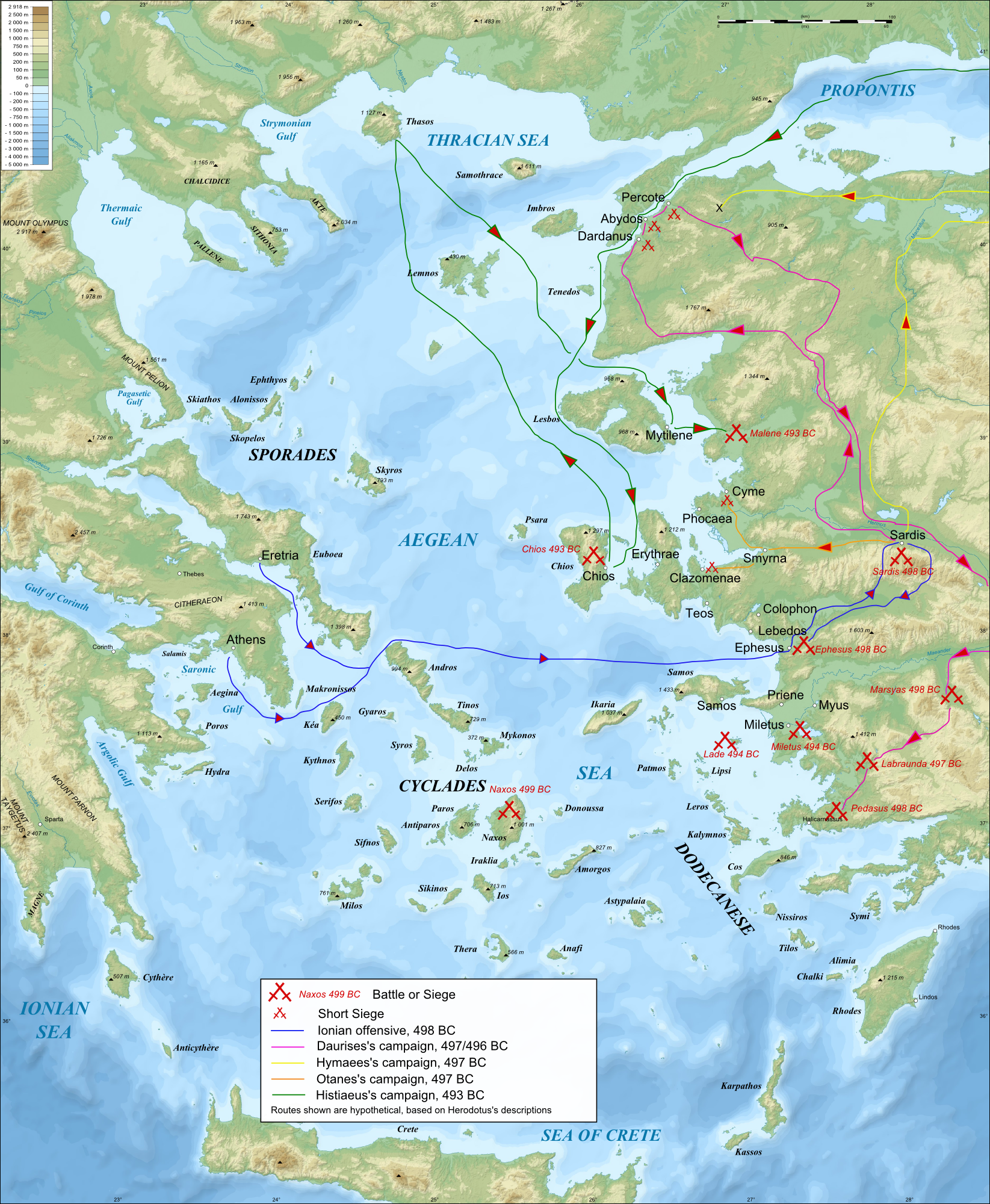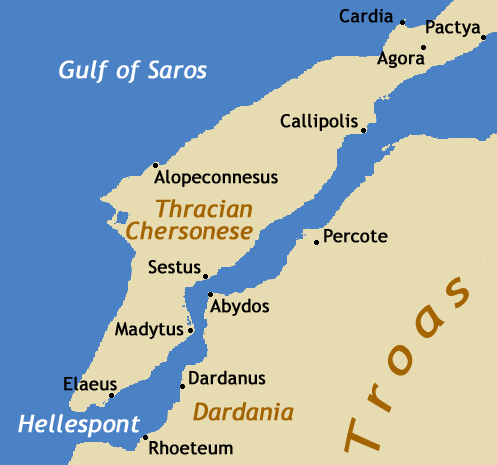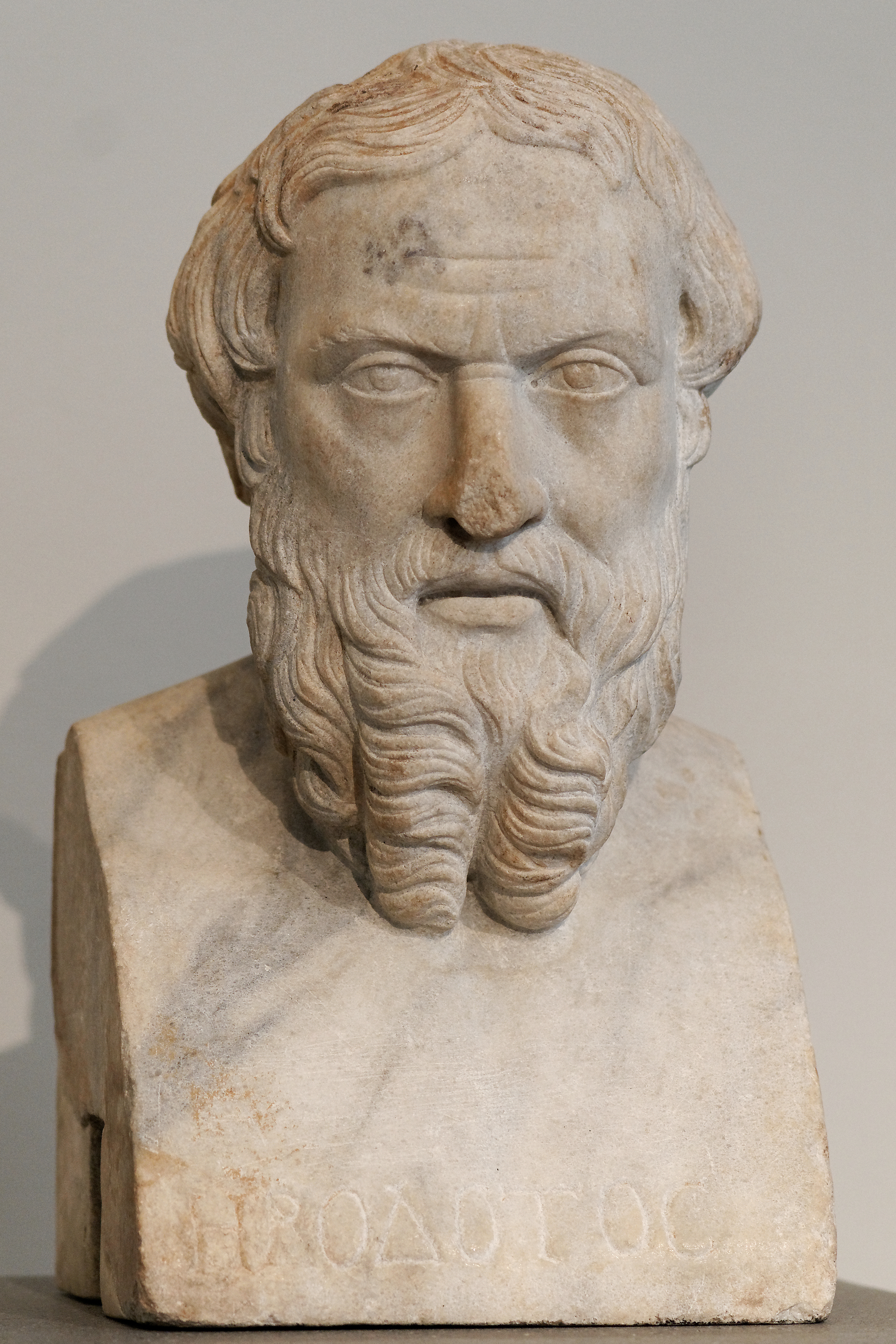|
499 BC
__NOTOC__ Year 499 BC was a year of the pre-Julian Roman calendar. In the Roman Empire it was known as the Year of the Consulship of Aebutius and Cicurinus (or, less frequently, year 255 '' Ab urbe condita''). The denomination 499 BC for this year has been used since the early medieval period, when the Anno Domini calendar era became the prevalent method in Europe for naming years. Events By place Greece * After a failed attack on the rebellious island of Naxos in 501 BC (on behalf of the Persians), Aristagoras, tyrant of Miletus, to save himself from the wrath of Persia, plans a revolt with the Milesians and the other Ionians. With the encouragement of Histiaeus (his father-in-law and former tyrant of Miletus), Aristagoras induces the Ionian cities of Asia Minor to revolt against Persia, thus instigating the Ionian Revolt and beginning the Greco-Persian Wars between Greece and Persia. The pro-Persian tyrant of Mytilene is stoned to death. * Miltiades the Younger, the ... [...More Info...] [...Related Items...] OR: [Wikipedia] [Google] [Baidu] |
Ionian Revolt Campaign Map
Ionic or Ionian may refer to: Arts and entertainment * Ionic meter, a poetic metre in ancient Greek and Latin poetry * Ionian mode, a musical mode or a diatonic scale Places and peoples * Ionian, of or from Ionia, an ancient region in western Anatolia * Ionians, one of four major tribes of the ancient Greeks * Ionian Sea, part of the Mediterranean Sea * Ionian Islands, a group of islands in Greece Language * Ionic Greek, an ancient dialect of the Greek language Science and technology * Ionian, of or relating to Io, a moon of the planet Jupiter * Ionian stage, a proposed name for the now-defined Chibanian stage in stratigraphy. * Ionic, of or relating to an ion, an atom or molecule with a net electric charge * Ionic (mobile app framework), a software development kit * Ionic bonding, a type chemical bonding * Ionic compound, a chemical compound involving ionic bonding Other uses * Ionian Technologies, an American biotechnology company * Hull Ionians, an English rugby club ... [...More Info...] [...Related Items...] OR: [Wikipedia] [Google] [Baidu] |
Ionian Revolt
The Ionian Revolt, and associated revolts in Aeolis, Doris, Cyprus and Caria, were military rebellions by several Greek regions of Asia Minor against Persian rule, lasting from 499 BC to 493 BC. At the heart of the rebellion was the dissatisfaction of the Greek cities of Asia Minor with the tyrants appointed by Persia to rule them, along with the individual actions of two Milesian tyrants, Histiaeus and Aristagoras. The cities of Ionia had been conquered by Persia around 540 BC, and thereafter were ruled by native tyrants, nominated by the Persian satrap in Sardis. In 499 BC, the tyrant of Miletus, Aristagoras, launched a joint expedition with the Persian satrap Artaphernes to conquer Naxos, in an attempt to bolster his position. The mission was a debacle, and sensing his imminent removal as tyrant, Aristagoras chose to incite the whole of Ionia into rebellion against the Persian king Darius the Great. In 498 BC, supported by troops from Athens and Eretria, the Ionians marched ... [...More Info...] [...Related Items...] OR: [Wikipedia] [Google] [Baidu] |
Cleomenes I
Cleomenes I (; Greek Κλεομένης; died c. 490 BC) was Agiad King of Sparta from c. 524 to c. 490 BC. One of the most important Spartan kings, Cleomenes was instrumental in organising the Greek resistance against the Persian Empire of Darius, as well as shaping the geopolitical balance of Classical Greece. Herodotus' account Most of the life of Cleomenes is known through the '' Histories'' of Herodotus, an Athenian historian of the second half of the 5th century. He is one the most important characters of books 5 and 6, covering the decades before the Persian Wars. Herodotus' account however contains many mistakes, especially on the chronology of several major events, and is also very biased against Cleomenes. It seems that Herodotus got his information on Cleomenes from his opponents: the descendants of his half-brothers Leonidas and Cleombrotus, as well as those of Demaratus, the other Spartan king who was deposed by Cleomenes in 491. Herodotus for instance states that C ... [...More Info...] [...Related Items...] OR: [Wikipedia] [Google] [Baidu] |
Imbros
Imbros or İmroz Adası, officially Gökçeada (lit. ''Heavenly Island'') since 29 July 1970,Alexis Alexandris, "The Identity Issue of The Minorities in Greece And Turkey", in Hirschon, Renée (ed.), ''Crossing the Aegean: An Appraisal of the 1923 Compulsory Population Exchange Between Greece and Turkey'', Berghahn Books, 2003p. 120/ref> ( el, Ίμβρος, Ímvros) is the largest island of Turkey and the seat of Gökçeada (district), Gökçeada District of Çanakkale Province. It is located in the north-northeastern Aegean Sea, at the entrance of Saros Bay, and has the westernmost point of Turkey (İncirburnu, Gökçeada, Cape İncirburnu). Imbros has an area of and has some wooded areas."Gökçeada" from Britannica Concise Encyclopedia According to the 2020 census, the island-district of Gökçeada has a population of 10,106 ... [...More Info...] [...Related Items...] OR: [Wikipedia] [Google] [Baidu] |
Lemnos
Lemnos or Limnos ( el, Λήμνος; grc, Λῆμνος) is a Greek island in the northern Aegean Sea. Administratively the island forms a separate municipality within the Lemnos regional unit, which is part of the North Aegean region. The principal town of the island and seat of the municipality is Myrina. At , it is the 8th-largest island of Greece. Geography Lemnos is mostly flat, but the west, and especially the northwest part, is rough and mountainous. The highest point is Mount Skopia at the altitude of 430 m. The chief towns are Myrina, on the western coast, and Moudros on the eastern shore of a large bay in the middle of the island. Myrina (also called Kastro, meaning "castle") possesses a good harbour. It is the seat of all trade carried on with the mainland. The hillsides afford pasture for sheep, and Lemnos has a strong husbandry tradition, being famous for its Kalathaki Limnou ( PDO), a cheese made from sheep and goat milk and melipasto cheese, and for ... [...More Info...] [...Related Items...] OR: [Wikipedia] [Google] [Baidu] |
514 BC
The year 514 BC was a year of the pre-Julian Roman calendar. In the Roman Empire, it was known as year 240 '' Ab urbe condita'' . The denomination 514 BC for this year has been used since the early medieval period, when the Anno Domini calendar era became the prevalent method in Europe for naming years. Events By place Asia * Suzhou City in China was founded by Wu Zixu * King Helu of Wu ascends to the throne of Wu in Zhou Dynasty China. He establishes Suzhou as his capital. * Darius I leads his Persian army across the Bosphorus and campaigns unsuccessfully against the Scythians on the Danube. Deaths *Harmodius and Aristogeiton, two men from ancient Athens who became known as the tyrannicides (τυραννοκτόνοι) after killing the Peisistratid ruler Hipparchus, and were the preeminent symbol of democracy to ancient Athenians. *Hipparchus, a member of the ruling class of Athens. He was one of the sons of Peisistratus Pisistratus or Peisistratus ( grc- ... [...More Info...] [...Related Items...] OR: [Wikipedia] [Google] [Baidu] |
Suzerainty
Suzerainty () is the rights and obligations of a person, state or other polity who controls the foreign policy and relations of a tributary state, while allowing the tributary state to have internal autonomy. While the subordinate party is called a vassal, vassal state or tributary state, the dominant party is called a suzerain. While the rights and obligations of a vassal are called vassalage, the rights and obligations of a suzerain are called suzerainty. Suzerainty differs from sovereignty in that the dominant power allows tributary states to be technically independent, but enjoy only limited self-rule. Although the situation has existed in a number of historical empires, it is considered difficult to reconcile with 20th- or 21st-century concepts of international law, in which sovereignty is a binary concept, which either exists or does not. While a sovereign state can agree by treaty to become a protectorate of a stronger power, modern international law does not recognise a ... [...More Info...] [...Related Items...] OR: [Wikipedia] [Google] [Baidu] |
Thracian Chersonese
The Thracians (; grc, Θρᾷκες ''Thrāikes''; la, Thraci) were an Indo-European speaking people who inhabited large parts of Eastern and Southeastern Europe in ancient history.. "The Thracians were an Indo-European people who occupied the area between northern Greece, southern Russia, and north-western Turkey. They shared the same language and culture... There may have been as many as a million Thracians, diveded among up to 40 tribes." Thracians resided mainly in the Balkans (mostly modern day Bulgaria, Turkey and Greece) but were also located in Anatolia (Asia Minor) and other locations in Eastern Europe. The exact origin of Thracians is unknown, but it is believed that proto-Thracians descended from a purported mixture of Proto-Indo-Europeans and Early European Farmers, arriving from the rest of Asia and Africa through the Asia Minor (Anatolia). The proto-Thracian culture developed into the Dacian, Getae, and several other smaller Thracian cultures. Thracian cult ... [...More Info...] [...Related Items...] OR: [Wikipedia] [Google] [Baidu] |
Miltiades The Younger
Miltiades (; grc-gre, Μιλτιάδης; c. 550 – 489 BC), also known as Miltiades the Younger, was a Greek Athenian citizen known mostly for his role in the Battle of Marathon, as well as for his downfall afterwards. He was the son of Cimon Coalemos, a renowned Olympic chariot-racer, and the father of Cimon, the noted Athenian statesman. Family Miltiades was a well-born Athenian, and considered himself a member of the Aeacidae, as well as a member of the prominent Philaid clan. He came of age during the tyranny of the Peisistratids. His family was prominent, due in good part to their success with Olympic chariot-racing.Creasy (1880) pg. 9 Plutarch claimed that Cimon, Miltiades' father, was known as "Coalemos", meaning "simpleton", because he had a reputation for being rough around the edges, but whose three successive chariot-racing victories at the Olympics made him popular, so popular in fact that, Herodotus claims, the sons of Peisistratos murdered him out of jealousy. ... [...More Info...] [...Related Items...] OR: [Wikipedia] [Google] [Baidu] |
Mytilene
Mytilene (; el, Μυτιλήνη, Mytilíni ; tr, Midilli) is the capital of the Greek island of Lesbos, and its port. It is also the capital and administrative center of the North Aegean Region, and hosts the headquarters of the University of the Aegean. It was founded in the 11th century BC. Mytilene is one of the two municipalities on the island of Lesbos, created in 2019; the other is West Lesbos. Mytilene is built on the southeast edge of the island. It is the seat of a metropolitan bishop of the Eastern Orthodox Church. History As an ancient city, lying off the east coast, Mytilene was initially confined to a small island just offshore that later was joined to Lesbos, creating a north and south harbor. The early harbors of Mytilene were linked during ancient times by a channel 700 m long and 30 m wide. The Roman writer Longus speaks of white stone bridges linking the two sides. The Greek word εὔριπος ''eúripos'' is a commonly-used term when referring to a st ... [...More Info...] [...Related Items...] OR: [Wikipedia] [Google] [Baidu] |
Ancient Greece
Ancient Greece ( el, Ἑλλάς, Hellás) was a northeastern Mediterranean civilization, existing from the Greek Dark Ages of the 12th–9th centuries BC to the end of classical antiquity ( AD 600), that comprised a loose collection of culturally and linguistically related city-states and other territories. Most of these regions were officially unified only once, for 13 years, under Alexander the Great's empire from 336 to 323 BC (though this excludes a number of Greek city-states free from Alexander's jurisdiction in the western Mediterranean, around the Black Sea, Cyprus, and Cyrenaica). In Western history, the era of classical antiquity was immediately followed by the Early Middle Ages and the Byzantine period. Roughly three centuries after the Late Bronze Age collapse of Mycenaean Greece, Greek urban poleis began to form in the 8th century BC, ushering in the Archaic period and the colonization of the Mediterranean Basin. This was followed by the age of Classical G ... [...More Info...] [...Related Items...] OR: [Wikipedia] [Google] [Baidu] |
Greco-Persian Wars
The Greco-Persian Wars (also often called the Persian Wars) were a series of conflicts between the Achaemenid Empire and Greek city-states that started in 499 BC and lasted until 449 BC. The collision between the fractious political world of the Greeks and the enormous empire of the Persians began when Cyrus the Great conquered the Greek-inhabited region of Ionia in 547 BC. Struggling to control the independent-minded cities of Ionia, the Persians appointed tyrants to rule each of them. This would prove to be the source of much trouble for the Greeks and Persians alike. In 499 BC, the tyrant of Miletus, Aristagoras, embarked on an expedition to conquer the island of Naxos, with Persian support; however, the expedition was a debacle and, preempting his dismissal, Aristagoras incited all of Hellenic Asia Minor into rebellion against the Persians. This was the beginning of the Ionian Revolt, which would last until 493 BC, progressively drawing more regions of Asia Minor into the co ... [...More Info...] [...Related Items...] OR: [Wikipedia] [Google] [Baidu] |






.jpg)
